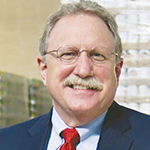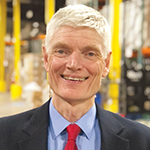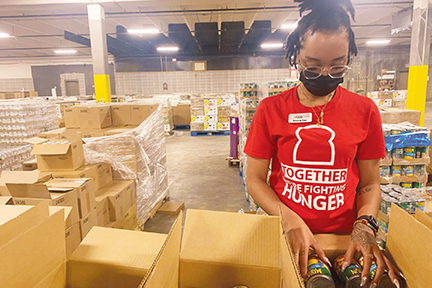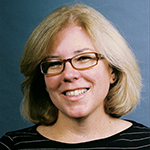By LISA EISENHAUER
During the worst days of the COVID-19 pandemic, the Greater Baton Rouge Food Bank set up distribution events that drew up to 2,000 people to claim a bag of groceries.

Manning
Mike Manning, the food bank's president and chief executive, says demand for food assistance spiked as the nation went into lockdown and jobs vanished. Once government supports kicked in and the economy got back on track, requests for aid ebbed, although
not quite to pre-pandemic levels.
Early this year, the demand began to rise again. "We're anticipating that we're going to see the number of people coming to us for help continue to increase as gas prices stay high, as food prices continue to go up, utility costs continue to rise, etcetera,"
says Manning. His organization assists 11 parishes in Southeastern Louisiana and works with dozens of partners, including Our Lady of the Lake Regional Medical Center, part of Franciscan Missionaries of Our Lady Health System.
People who oversee food banks or meal programs elsewhere in the nation report a similar recent surge in requests for aid. They cite the rise in the cost of living — especially for housing and fuel — as well as the tapering off of pandemic assistance as
drivers of the increased need.
'Need is not abating'
Data that confirms the upswing is hard to come by. However, the Capital Area Food Bank released a report in June on
the sustained need. The report, based on surveys done in February and March, says that one-third of the households in the District of Columbia and in the areas of Maryland and Virginia the food bank covers self-identified as being food insecure.
"Last year, the Capital Area Food Bank distributed more than 64 million meals — a higher number than any single calendar year in its history, and more than double the levels of 2019," the report says. "Today, in the face of rising inflation and ongoing
shifts in the global economy that continue to affect many people, that need is not abating."
Feeding America, an umbrella group that supports 200 food banks and 60,000 food pantries and meal programs across the nation, estimates that 53 million Americans turned to those food programs for assistance last year, about one-third more than in 2019,
before the start of the pandemic.
Zuani Villarreal, Feeding America's director of communications, says a survey done this spring found that 80% of the agencies in its network saw increased demand compared to the month before. "So the trend is going up, not down," she says.
Villarreal points out that food insecurity exists in every community to varying degrees and its impact is disparate. For example, she says, two-thirds of households that report lacking access to adequate food have children; compared to white Americans,
Blacks are 3.2 times more likely, Native Americans 3 times more likely and Latinos 2.5 times more likely to be food insecure.
Recovery undercut
Tom Mulhern is executive director of FOOD for Lane County, which is based in Eugene, Oregon, and counts Vancouver, Washington, based-PeaceHealth among its partners. He credits federal pandemic aid and policies, such
as stimulus funds, increased Supplemental Nutritional Assistance Program benefits, rental assistance, unemployment benefit extensions and the eviction moratorium, with keeping the public health emergency from creating a wider social crisis.

Mulhern
"That was a success story that really hasn't been told, I don't think, to a great degree," Mulhern says.
As the pandemic eases, that targeted assistance is vanishing or is expected to. Even if some of it stays in place, Mulhern says inflation is chipping away at the effects.
"What we're seeing in recent months is with the rising cost of food, which is now accompanied by the rising cost of gas, that naturally people's income and resources aren't lasting as long," he says. "People are running out of food and running out of
money earlier in the month."
He notes that unlike other expenses, such as rent and car payments, food costs are flexible for most families. "They exercise that flexibility out of necessity and the end result is kind of substandard diets for many people, not because they're not aware
but because of economic reality," he says. "They're making the best choices they can given their economic situation."
Helping their own
Josh Brinkley is director of community health improvement for St. Louis-based SSM Health, one of many Catholic health systems that have expanded support for food assistance programs during the pandemic.
He says food insecurity is a priority for the health system because it regularly shows up as a need in community health needs assessments and because the link between nutrition and health is well established.
"There's an opportunity for us through some of these programs and through some of our broader efforts to get more upstream in helping folks address their social determinant of health needs," he explains.
Brinkley says the volunteers who work at food distribution sites that SSM Health supports report that requests for the aid are on the rise. At food giveaways SSM Health has set up in partnership with the St. Louis Area Food Bank, including at two SSM
Health sites, some of the people picking up food boxes are part of the system's workforce.
That is in spite of the fact that SSM Health is among the many Catholic health systems that last year raised its minimum hourly wage to $15, more than double the federal minimum of $7.25.
"We're doing our best to address the needs of all members of our communities and in some cases that does include members of our staff," Brinkley says.
Erica Phillips, community health investment manager for Providence St. Joseph Health, says her system also is aware of some of its own workers seeking out food assistance in the High Desert region of California where she is based.
Like SSM Health, Providence's lowest wages are well above the federal base. Phillips points out that in a state like California where the average gas price was above $6 a gallon in early July and housing costs are among the nation's highest, many working
families are struggling.

A staff member sorts canned goods in the warehouse of the Greater Baton Rouge Food Bank in Louisiana. Across the U.S., food banks like this one, which supply food pantries and soup kitchens in their communities and sometimes distribute food directly,
have seen requests for groceries rise as food prices soar.
Greater Baton Rouge Food Bank
As part of its food-assistance efforts, Providence is working with a food bank to establish a distribution point at a Providence hospital campus to provide staples and fresh foods to both caregivers and the community.
Agencies feel pinch
Food banks are experiencing the pinch of rising costs and the scarcity of some items. Most of FOOD for Lane County's supplies come from a mix of public and private donations. It gets support from Chicago-based
Feeding America.
Mulhern says pre-pandemic, less than 1% of his organization's budget went for food purchases. More recently, because of inflation and supply chain issues, close to 10% of its budget is being used to shore up supplies.
In Baton Rouge, Manning says his food bank wasn't able to give away a hen to every family in need for the winter holidays last year as hoped. Its order for thousands of birds was canceled when the supplier ran short. This year, the food bank put its order
in early and plans to get the hens in multiple shipments and store them.

Stenson
Jane Stenson, vice president of food and nutrition and poverty reduction strategies for Catholic Charities USA, says it can be difficult just keeping staples on shelves at food banks. She recently visited one of the 167 agencies under her organization's
umbrella and learned that its New York City facility was challenged in having enough rice, beans and oatmeal on hand to meet demand.
From temporary to permanent
In addition to helping agencies within its network operate their food programs with optimal effect, Catholic Charities USA does advocacy work to influence national policy on food aid. Stenson says one of
its current priorities is keeping the pandemic-related benefits in place.
Among those that have been especially helpful, she says, are the boost in SNAP allocations and the expansion almost nationwide of what had been a pilot program in just two states. The program allows SNAP recipients to use electronic benefit transfers
to make food purchases online. SNAP users can then arrange for curbside pickups or deliveries.
"If people qualify, we really encourage them and try to support them to get SNAP," Stenson says. "It's just a tremendous way to not be so reliant on the food pantries because often their assistance can only come once a month."
Villarreal says Feeding America also is urging policymakers to retain food program expansions that were put in place as temporary responses to the pandemic. "We can't take anything away right now," she says. "We need to provide everything we can because
families are still struggling."
Catholic health systems step up food support
Several Catholic systems across the country started new food assistance programs or joined collaboratives addressing food insecurity during the pandemic and plan to keep the programs in place even as the health emergency wanes. Here are a few
of those programs:
- SSM Health partnered with the University of Illinois Extension Service in spring 2020 to start a Mobile Markets program that once a month distributes produce, dairy products and healthy recipes to two communities in Southern Illinois. In 2021,
the markets gave away more than 5,500 food boxes.
- Providence St. Joseph Health, through its charitable arm St. Joseph Community Fund, in early 2021 provided funding to the High Desert Food Collaborative in Southern California. Among the collaborative's initiatives are to set up a central
food bank for nonprofits to get food at a lower cost. Providence St. Mary Medical Center in Apple Valley, California, is a founder and continuing supporter of the collaborative.
- Last September, Our Lady of the Lake Regional Medical Center began partnering with the Greater Baton Rouge Food Bank as part of a program called Geaux Get Healthy. Patients who indicate during an intake screening that they are food insecure
get a 20-pound box of healthy foods individually built by the food bank's nutrition services team and information to help them source food through one of the bank's member agencies.
- In December, PeaceHealth Sacred Heart Medical Center at RiverBend in Springfield, Oregon, began a Family Meal Kit project with FOOD for Lane County. The kits provide families of pediatric patients who are experiencing food insecurity enough
food for a day, resources on where to get more and referrals to a pediatric social worker.